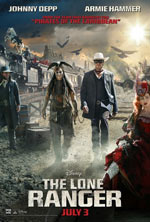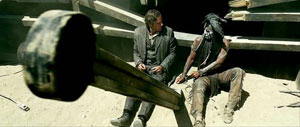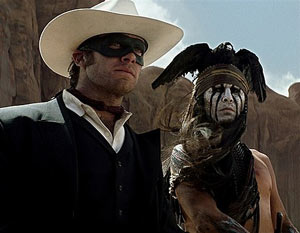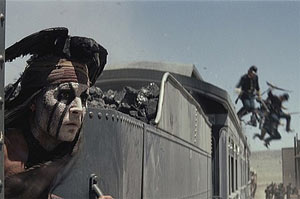
The Lone Ranger

 – for sequences of intense action and violence, and some suggestive material.
– for sequences of intense action and violence, and some suggestive material.
Director: Gore Verbinski
Starring: Johnny Depp, Armie Hammer, William Fichtner, Tom Wilkinson, Ruth Wilson, Helena Bonham Carter, James Badge Dale
Running Time: 2 hours, 29 minutes
Theatrical Release Date: July 3, 2013
Official Site

Plot Summary
Native American spirit warrior Tonto (Johnny Depp) and man of the law John Reid (Armie Hammer) are opposites brought together by fate and must join forces to battle greed and corruption.
(from MovieWeb.com)
Film Review
The western seems to be an ailing movie genre. When film was in its golden years, westerns were about as common as anything else you might see in the theaters today. But lately, when Hollywood tries to bring something unique to the big screen in the form of a western, it doesn’t quite connect with audiences. I very much enjoyed 2011’s Cowboys and Aliens, but the concept alone–cowboys with aliens–had many viewers struggling to buy into the graphic novel-turned-feature film’s concept. Perhaps with the success of the more mature True Grit in 2010 lead to The Lone Ranger finally becoming a reality, but the ingredients that were assembled to bring this film to the big screen were not quite the right ones. After all, an American classic hero like The Lone Ranger deserves a fantastic modern update, but it doesn’t look like Disney and director Gore Verbinski had everything in order to make that happen.
The Lone Ranger tells the story of a city lawman, named John Reid, who visits the gritty west to visit his brother, one of the town’s Rangers. However, a ruthless outlaw takes out all of the Rangers–including Reid, and a local Native American outcast named Tonto helps in resurrecting the Lone Ranger to bring justice to the villain. Verbinski’s approach to the story is on par with his Pirates of the Caribbean filmmaking style. In fact, The Lone Ranger feels as if it could exist in the exact same world that Verbinski created for Pirates. You could almost imagine Tonto (played by Johnny Depp) running into Jack Sparrow (also played by Depp) at some point. The world is dark, gritty, and somewhat surreal. Verbinski took a bigger-is-better approach to each succeeding Pirates entry, which allowed for the concepts to get more outrageous with each installment in the franchise. While the first movie, The Curse of the Black Pearl, dealt with cursed pirates who turned into skeletons in the moonlight, things got considerably more fantastical with each sequel. The skeleton pirates were replaced by supernatural fish pirates in Dead Man’s Chest, a deceased pirate was raised from the dead, and a sea monster was introduced into the fold. Furthermore, the third film just threw caution to the wind, offering a seemingly infinite number of Jack Sparrows, supernatural crabs, and cast a rock legend to pose as Jack’s father. Point being – Verbinski seems to have lost a grip on what feels tangible for the world he creates for his characters. 2011’s bizarre animated feature Rango is further proof of this. In The Lone Ranger, there’s a spiritual element to the story once again, one that’s mostly rooted in the spiritual beliefs of the Native Americans, with the Lone Ranger being a “spirit walker” and there being a horse with strange and unexplainable connections to the spirit world. And, at one point, in a truly George Lucas kind of way, we’re shown wild animated rabbits with fangs that are used to illustrate how nature has been thrown “off balance.” But it’s corny, clearly CG, and something that anyone who has seen Monty Python and the Holy Grail will find utterly ridiculous.

And that’s The Lone Ranger‘s biggest problem; it’s a hybrid of genres and tones without ever feeling like it gets any of it just right. Oil and water is an analogy that comes to mind. The story is told in flashback, a decision that doesn’t seem to have any good explanation. A little boy who is dressed as the Lone Ranger meets a freakishly elderly Tonto who is unexplainably posing as a statue in a sideshow exhibit and suddenly comes to life. He mistakes the boy for the Lone Ranger somehow and proceeds to tell him the story of John Reid. The two interrupt the story a few times to remind you that they’re still there, but ultimately it adds nothing to the story and doesn’t really make much sense. If anything, it seems like a way to draw children in to the story, but then Verbinski’s direction of the film feels mostly very adult (perhaps the flashback narrative was a demand by Disney in post production to lighten the tone of the movie a hair). Verbinski seems to go out of his way to make the spit and blood of the Old West a visible and real attribute. The camera lingers on bloody imagery and does not cut away from moments that should most certainly be left up to the imagination. Just when you think the violence has been toned down a tad, the camera goes back over a dead body to focus on the bloody clothes and bullet wounds on a dead corpse. It’s a most bizarre choice for a supposed “family film.” And if it seems like Gore has settled on this more edgy adult approach to the Lone Ranger story, he inserts some oddball humor or imagery to shake things up. And while Jack Sparrow is hardly a serious character, Tonto is presented as a mix of serious with a splash of that Jack Sparrow goofiness. If we didn’t already have four (with a possible fifth on the way) movies-worth of Jack Sparrow already, Depp’s performance as Tonto would feel entirely fresh, but instead, he offers a mostly new character (for him), with then glaringly similar facial expressions and mannerisms as Sparrow. Otherwise, Depp excels at making Tonto a likeable and interesting character.
The content for The Lone Ranger is a very, very hard PG-13. The worst moment in the movie involves Butch Cavendish hovering over a downed Ranger who’s bleeding out. We then see a side view of this as Butch drives his knife into what looked like the stomach region of the Ranger. We then see the Ranger’s face as his body moves violently below the frame as Butch apparently starts to cut him open. Reid looks on as this is happening and we see the distorted reflection in his pupil of Butch eating (yes, eating) the Ranger’s heart while bending over the man’s body. We then see the dead face of the Ranger (eyes are still open) and blood all over his clothes, while Butch has blood all over his mouth. It’s pretty disgusting to say the least. Other violence includes characters being shot up and killed, usually with bloody results, and many other kinds of deaths. The finale is pretty brutal, too, with the Indians attacking the soldiers with flaming arrows, while the soldiers shoot back, including with a gattling gun. The language isn’t too bad, being mostly uses of “h*ll” and “d*mn,” and variations of “Oh my G-d,” but there’s some sensuality when the duo visit a brothel to speak to Red Harrington (played by Helena Bonham Carter). Inside, they see many buxom women with men drinking and partying. At one point, Red spots a man getting frisky with a woman and Red props her ivory fake leg up on a balcony rail and fires it at the man, telling him “no free rides.” Later, we see a soldier lusting after her ivory leg, asking her how far it goes up.

With everything wrong with The Lone Ranger, it’s easier to pick out what didn’t work over what actually did work. The plot is a bit familiar, if not predictable at times, but the pairing of Armie Hammer as John Reid and Depp as Tonto usually works for much of the film. But by the end of the movie, when Hammer has finally settled in as the Lone Ranger, I felt like whatever adventure they were riding off to be a part of would probably have been a more fun movie than this origin story. Still, the acting is pretty solid in the film (save for Bryant Prince as Danny, the whiney son of Rebecca Reid), and William Fichtner, who is typically an intense actor, is downright creepy as Butch Cavendish. Tom Wilkinson is good as Cole, but the role is all too familiar for him (and I could name at least one other movie from the late 90s that had him playing a similar character, but I won’t spoil that here), and Ruth Wilson is pretty good as Rebecca Reid, playing a love interest to the Reid boys who fits the time period without looking like she was lifted out of the page of an airbrushed pin-up magazine. One of the greatest merits of the film is Hans Zimmer’s booming score. It’s a bit too close to Pirates of the Caribben at times (even the western tune they briefly used in At World’s End), but it suits Verbinski’s film appropriately, and makes the movie seem a little better than it actually is.
It’s too long, it’s paced inconsistently, it’s way too violent, and it’s tonally inconsistent; The Lone Ranger may still be a watchable summer movie (and not nearly, nearly as bad as Wild Wild West), but you can’t help but feel like it should have been better–and that the Lone Ranger deserved a better movie. Verbinski may need to reinvent his directorial approach (or Disney needs to just sever ties with him), as he clearly has lost sight of what makes for good entertainment for the family. A sequel could still be warranted given better direction and story, but as it is, The Lone Ranger is ultimately a glorified misfire.
– John DiBiase, (reviewed: 7/9/13)
Parental Guide: Content Summary
![]() Sex/Nudity: John and Tonto go into a brothel where we see many women wearing busty dresses with drunken men around them. They talk to Red briefly and she shows them a fully ivory fake leg in place of her right one; We see Captain Fuller lusting over Red’s ivory leg. She invites him to touch it and we see him practically drooling over it as he touches it and asks her how far it goes up her body; We see advertisement’s for Red’s brothel, which she herself calls a “place of sin;” Butch asks what it is about Rebecca that has the Reid boys so interested in her, and he comments that he should taste and see (meaning sex); We see a male outlaw who wears women’s clothing he stole, including carrying one of their umbrellas around.
Sex/Nudity: John and Tonto go into a brothel where we see many women wearing busty dresses with drunken men around them. They talk to Red briefly and she shows them a fully ivory fake leg in place of her right one; We see Captain Fuller lusting over Red’s ivory leg. She invites him to touch it and we see him practically drooling over it as he touches it and asks her how far it goes up her body; We see advertisement’s for Red’s brothel, which she herself calls a “place of sin;” Butch asks what it is about Rebecca that has the Reid boys so interested in her, and he comments that he should taste and see (meaning sex); We see a male outlaw who wears women’s clothing he stole, including carrying one of their umbrellas around.
![]() Vulgarity/Language: About 15 “h*ll,” 7 “d*mn,” 7 variations of “G-d”
Vulgarity/Language: About 15 “h*ll,” 7 “d*mn,” 7 variations of “G-d”
![]() Alcohol/Drugs: A woman appears to be drugged with lipstick that someone else puts on her; We see people drinking beer on a train; We see a few saloon scenes involving characters drinking at a bar; We see drinking at a bar in a brothel; Tonto’s horse drinks a bottle of liquor; We see people drinking wine in a few scenes; Some outlaws drink whiskey from bottles/flasks while on horseback; One of the men traveling with the Rangers appears to be frequently drinking/drunk
Alcohol/Drugs: A woman appears to be drugged with lipstick that someone else puts on her; We see people drinking beer on a train; We see a few saloon scenes involving characters drinking at a bar; We see drinking at a bar in a brothel; Tonto’s horse drinks a bottle of liquor; We see people drinking wine in a few scenes; Some outlaws drink whiskey from bottles/flasks while on horseback; One of the men traveling with the Rangers appears to be frequently drinking/drunk
![]() Blood/Gore: We see a couple close-ups of Butch trying to pull a nail out of a floorboard, with blood all over his fingertips; We see Butch Cavendish hovering over a downed Ranger who’s bleeding out. We then see a side view of this as Butch drives his knife into what looked like the stomach region of the Ranger. We then see the Ranger’s face as his body moves violently as Butch apparently starts to cut him open. Reid looks on as this is happening and we see the distorted reflection in his pupil of Butch eating the Ranger’s heart while bending over the man’s body. We then see the dead face of the Ranger (eyes are still open) and blood all over his clothes, while Butch has blood all over his mouth; The camera pans over fallen Rangers and we see bullet holes in their clothing and blood on their clothes; We see several graves dug out with dead men in them with some blood on their clothes; There’s some blood on a bandit who is hit in the chest with a knife from Tonto; We see a whole Indian camp had been torched and killed, with a lot of dead bodies lying on the ground (may be some blood); We see a skinned rabbit roasting on a fire. Tonto then rips off a piece of the meat and throws it to some nearby living rabbits who then reveal fangs and violently devour the meat (with bloody results); Butch’s face is bloody after being struck there repeatedly; Butch’s lip is badly scarred throughout the movie and appears to be missing part of it.
Blood/Gore: We see a couple close-ups of Butch trying to pull a nail out of a floorboard, with blood all over his fingertips; We see Butch Cavendish hovering over a downed Ranger who’s bleeding out. We then see a side view of this as Butch drives his knife into what looked like the stomach region of the Ranger. We then see the Ranger’s face as his body moves violently as Butch apparently starts to cut him open. Reid looks on as this is happening and we see the distorted reflection in his pupil of Butch eating the Ranger’s heart while bending over the man’s body. We then see the dead face of the Ranger (eyes are still open) and blood all over his clothes, while Butch has blood all over his mouth; The camera pans over fallen Rangers and we see bullet holes in their clothing and blood on their clothes; We see several graves dug out with dead men in them with some blood on their clothes; There’s some blood on a bandit who is hit in the chest with a knife from Tonto; We see a whole Indian camp had been torched and killed, with a lot of dead bodies lying on the ground (may be some blood); We see a skinned rabbit roasting on a fire. Tonto then rips off a piece of the meat and throws it to some nearby living rabbits who then reveal fangs and violently devour the meat (with bloody results); Butch’s face is bloody after being struck there repeatedly; Butch’s lip is badly scarred throughout the movie and appears to be missing part of it.
![]() Violence: Extreme violence. Some slapstick violence, but mostly serious violence: An outlaw shoots two men and his posse rob a train, shooting a priest in the leg, among other things; A train wreck happens, throwing Tonto and John from the train. They survive but are almost crushed by the engine sliding toward them on the ground; An outlaw falls from the train and is trampled by horses but later appears to be mostly fine; A group of Rangers are gunned down off their horses and killed. Butch cuts one while he’s lying there dying and eats part of his heart (we see this in the reflection of another person’s eye). He then leaves. We then see the dead corpses on the ground and then several grades dug out with the bodies inside them. One pops up, apparently still alive (or having come back to life) and Tonto strikes them on the head with a rock (or shovel?); John is struck in the shoulder with an arrow; Some apparent Comanches attack Rebecca’s home and they shoot and kill a man and slice at him (apparently scalping him), but we don’t see any gory details; A horse falls over dead in the desert; In a flashback, we see two men lying on the ground, left for dead. A young Comanche saves them, but we later learn that they burn his village and kill everyone in it; Some Comanches hold knives/blades on John, but he escapes the situation; John fires his gun which accidentally ricochets off some things and hits the raven on Tonto’s head. It also causes a huge wooden beam to land on top of two outlaws’ heads. We then see a closer view of their bodies lying under the beam, implying that their heads were squashed beneath it; A man is hit in the face repeatedly and another man hits Tonto over the head, knocking him out; We hear the screams of a man in a train tunnel before he’s knocked out (not seen); A boy holds a gun on a man and another man tells him to shoot a Ranger. He doesn’t, however; We see Tonto and Reid buried up to their necks in the ground, and scorpions crawl all over their heads and faces; A boy hits a man with fruit with a slingshot; Red shoots at a man, using a gun hidden in her fake leg, in her brothel to get him to stop misbehaving; Later in the movie, Red shoots some explosives to cause a diversion; A train accidentally knocks over a band stand; A man is put in front of a firing squad and is saved at the last minute; A man throws dynamite down a mine shaft where Tonto and Reid are, but they escape; Comanches attack a group of soldiers and the soldiers fight back, killing them. We see the chief stabbed to death just out of view of the frame, but see both his face and the face of his stabber; There’s a huge train chase sequence with lots of gunfire, some deaths, breaking glass, etc. One train goes off a cliff, killing a man stuck on that train; Another train loaded with silver falls off a bridge into water, crushing the man in the water below. But we see the man sinking and his hand sticking out from the chunks of rock as it all sinks; There’s lots and lots of other western-style violence.
Violence: Extreme violence. Some slapstick violence, but mostly serious violence: An outlaw shoots two men and his posse rob a train, shooting a priest in the leg, among other things; A train wreck happens, throwing Tonto and John from the train. They survive but are almost crushed by the engine sliding toward them on the ground; An outlaw falls from the train and is trampled by horses but later appears to be mostly fine; A group of Rangers are gunned down off their horses and killed. Butch cuts one while he’s lying there dying and eats part of his heart (we see this in the reflection of another person’s eye). He then leaves. We then see the dead corpses on the ground and then several grades dug out with the bodies inside them. One pops up, apparently still alive (or having come back to life) and Tonto strikes them on the head with a rock (or shovel?); John is struck in the shoulder with an arrow; Some apparent Comanches attack Rebecca’s home and they shoot and kill a man and slice at him (apparently scalping him), but we don’t see any gory details; A horse falls over dead in the desert; In a flashback, we see two men lying on the ground, left for dead. A young Comanche saves them, but we later learn that they burn his village and kill everyone in it; Some Comanches hold knives/blades on John, but he escapes the situation; John fires his gun which accidentally ricochets off some things and hits the raven on Tonto’s head. It also causes a huge wooden beam to land on top of two outlaws’ heads. We then see a closer view of their bodies lying under the beam, implying that their heads were squashed beneath it; A man is hit in the face repeatedly and another man hits Tonto over the head, knocking him out; We hear the screams of a man in a train tunnel before he’s knocked out (not seen); A boy holds a gun on a man and another man tells him to shoot a Ranger. He doesn’t, however; We see Tonto and Reid buried up to their necks in the ground, and scorpions crawl all over their heads and faces; A boy hits a man with fruit with a slingshot; Red shoots at a man, using a gun hidden in her fake leg, in her brothel to get him to stop misbehaving; Later in the movie, Red shoots some explosives to cause a diversion; A train accidentally knocks over a band stand; A man is put in front of a firing squad and is saved at the last minute; A man throws dynamite down a mine shaft where Tonto and Reid are, but they escape; Comanches attack a group of soldiers and the soldiers fight back, killing them. We see the chief stabbed to death just out of view of the frame, but see both his face and the face of his stabber; There’s a huge train chase sequence with lots of gunfire, some deaths, breaking glass, etc. One train goes off a cliff, killing a man stuck on that train; Another train loaded with silver falls off a bridge into water, crushing the man in the water below. But we see the man sinking and his hand sticking out from the chunks of rock as it all sinks; There’s lots and lots of other western-style violence.
